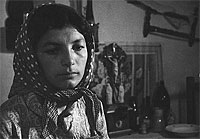 Cigányok
Cigányok
Hungary, 1962, black and white, 17 mins
If the IMDB is to be believed, this short documentary made for the renowned Béla Balázs Studio is the directorial debut of Sándor Sára, who went on to forge a distinguished career as both director of his own films and cinematographer of other people’s, notably Ten Thousand Suns (Tízezer nap, d. Ferenc Kósa, 1967), Sindbad (Szindbád, d. Zoltán Huszárik, 1971) and many early István Szabó features (Sára’s cinematographer here is István Gaál, also a future director). This short film is a quasi-anthropological study of a group of gypsies living in a makeshift encampment far away from any significant Hungarian population centre, but at the same time being expected to integrate convincingly into “normal” society.
It begins with a series of stark black-and-white still photographs of gypsies, with an emphasis on small children staring directly at the camera, a motif that continues through the moving-image material. A percussive accompaniment segues into a gypsy folksong about people who disappear out of the blue, and those who are punished by the authorities even when innocent. The camera circles around the gypsy settlement, whose huts have clearly been built by their inhabitants. Mothers take their young children to a medical centre, whose doctors diagnose that they’re suffering from malnutrition, especially lack of milk (a voiceover highlights that many gypsy children are badly stunted both physically and mentally as a result of early nutritional deprivation).
While the kids form themselves into lines to watch cars, boats and trains passing, their elders describe the trials of their lives in voiceover: society is supposed to help the poor, but gypsies barely register. Despite endless applications, they’re passed over for social housing, and a typical monthly income of 700-800 forints barely leaves enough over for food. As one pithily puts it “honesty leaves us when we have no work”, but even when they get work they’re mercilessly exploited. They eventually had to build the settlement themselves, but they’re currently stuck there, as they have no resources to build anything better.
Sára intercuts these with glimpses of authentic folk culture. A funeral sees the corpse in an open coffin surrounded by keening headscarfed women. One tells a proverb about how gypsies used to be birds, flying from place to place in search of food, but when they alighted on a huge surplus, they stayed too long to indulge, and their wings turned into hands. The menfolk work in iron, illustrated by a rapid montage set to a rhythmic, percussive score.
The rest of the film concentrates on the lives of the children, first seen walking three kilometres to school, mostly along a dirt track, with many barefoot. As they attend class, they describe their dream careers in considerable detail: nurse, teacher, ticket collector. When they reach the school, they wash in a small tin tub outside and hang their coats on a pair of rickety beams. A girl recites Vladimir Mayakovsky, a boy Sándor Petőfi – both revolutionary poets, though the film doesn’t emphasise this. A brief sequence of the kids copying a blackboard drawing of a peasant woman bending over a field is echoed in the film’s final shot as a gypsy boy draws a similar picture from memory on the wall of the family home. Though Sára’s film is for the most part bleak and pessimistic, this does at least hint at the possibility that the kids’ education is working outside the confines of the classroom, and they at least might have a faint hope of a better future.
- Director: Sándor Sára
- Screenplay: Sándor Sára
- Photography: István Gaál
- Editing: István Gaál
- Sound: Gyula Novák
- Producer: András Nemeth
- Production Company: Béla Balázs Studio
Links
- The Béla Balázs Studio website entry includes a video extract from near the end of the film, as the children return from school (no spoken dialogue).
- Internet Movie Database